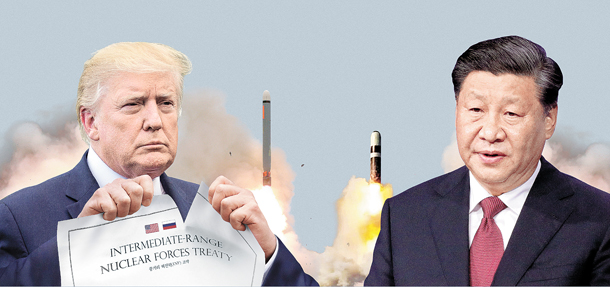A new missile war

The author is a senior columnist at the JoongAng Ilbo.
The Cold War came to an end in 1991 with the dissolution of the Soviet Union. Years from now, historians may recall 2019 as the beginning of Cold War II, when the United States engaged in an all-out trade war with the rising superpower of China, kicking off an arms race between the two nations. At the core of this arms race are missiles.
Washington’s withdrawal from the Intermediate-Range Nuclear Forces (INF) Treaty early last month signaled the start of Cold War II, and with that, the United States strived to narrow its gap with China on missile development. China’s attempt to seize regional hegemony in East Asia and the United States’ effort to block this will likely have a huge impact not only on the Korean Peninsula, but also on all of East Asia.
The INF Treaty is formally known as the Treaty Between the United States of America and the Soviet Socialist Republics on the Elimination of Their Intermediate-Range and Shorter-Range Missiles. The treaty is based on an agreement signed in December 1987 between U.S. President Ronald Reagan and Soviet General Secretary Mikhail Gorbachev, which banned the two countries’ land-based short- and intermediate-range ballistic missiles, cruise missiles and missile launchers with ranges between 500 and 5,500 kilometers (310 to 3,420 miles) from being produced, tested and deployed. The treaty was ratified in June 1988. Over three years after the treaty went into effect, the two countries scrapped a total of 2,692 missiles, including 846 from the United States and 1,846 from the Soviets. The INF, which paved the way for the Cold War to end, was hailed as the most successful arms reduction treaty in decades.
Russia and the United States were tethered to the INF. China wasn’t, and it did not hesitate to develop and drastically increase its stock of short- and intermediate-range ballistic missiles and cruise missiles. U.S. Ambassador to Seoul Harry Harris, in his previous role as head of the U.S. Pacific Command in 2017, said that the Chinese People’s Liberation Army had “the largest and most diverse missile force in the world,” continuing that 95 percent of those missiles would be a violation of the INF if China were a signatory. U.S. President Donald Trump’s administration’s purported reason for pulling out of the INF was that Russia was not abiding by the treaty. Its underlying reason, however, is China’s astronomical missile development — and the fear that the United States will not be able to catch up if it does not do anything about it fast.
The great game between the two superpowers all comes down to naval power. China’s islands chain strategy refers to a line of major archipelagos the country has drawn in the East Sea to block advancing U.S. naval forces. The first island chain, which is about 1,000 kilometers away from Chinese shorelines, links Japan, Taiwan, the Philippines, Indonesia and Vietnam. The second island chain, about 2,000 kilometers away from Chinese shorelines, connects the Ogasawara Islands and Iwo Islands of Japan, the Mariana Islands and Guam of the United States and the island country of Palau. Its vast development of naval power and aircraft carriers are part of those goals, as well as its creation of military bases in the South China Sea.

The pillar of China’s island chain theory lies in the development of intermediate-range ballistic missiles targeting the U.S. carrier strike groups and advanced air bases in East Asia. China’s DF-21D, which entered service in 1991, is the world’s first anti-ship ballistic missile and can travel 1,800 to 3,000 kilometers. It’s dubbed the “carrier killer” because its main purpose is to defend against aircraft carriers. It can also attack land targets, including all of Japan and the U.S. base in Japan’s southernmost prefecture of Okinawa.
The DF-26, an improved version of the DF-21D, was put into service last year. It is known as the “Guam killer” due to its capability of targeting the U.S. island in the western Pacific with a range between 3,000 and 4,000 kilometers. China’s DF-16, put to service in Shandong, China, can travel as far as 1,000 kilometers and hit the U.S. base in Pyeongtaek, Gyeonggi as well as the United States-led Terminal High Altitude Area Defense (Thaad) antimissile system in Seongju County, North Gyeongsang with a margin of error below 10 meters (33 feet). The DF-15 ballistic missile stationed on China’s southeastern coast can travel 600 to 1,000 kilometers, enough to target Taiwan. China is equipped with a full range of missiles from short-range and intermediate-range ballistic missiles to intercontinental ballistic missiles, even some that the United States and Russia have yet to develop due to the restrictions of the INF Treaty.
The United States has tried to counter the Chinese threat by developing sea-to-air and air-to-air missiles, which are exceptions to the INF. However, those missiles have a huge difference from ground-to-air missiles in that they can only be temporarily deployed. The aircraft carriers, submarines, destroyers and fighter jets that the United States deploys to Asia when tensions rise return to their home base once their missions are over; they’re not permanently around. Ground-based missiles, on the other hand, can stay eternally at a set location. The United States, in this sense, must have concluded that the only way to narrow the gap between China in missile development would be to withdraw from the INF.
Washington has been spurring momentum in its development of short- and intermediate-range ballistic missiles since it withdrew from the INF. Sixteen days after it left the arms reduction treaty, it test-fired a cruise missile that has a range of 500 kilometers. The U.S. military is planning to produce more short- and intermediate-range ballistic and cruise missiles by the end of this year and place them all over Asia starting next year, creating a permanent ring of missiles around China to pull down the country’s Anti-Access/Area Denial ambition. New U.S. Secretary of Defense Mark Esper, who made his first overseas trip as the Pentagon chief to Asia early last month, said he wanted to deploy an intermediate-range conventional missile in the Pacific region within months.
Beijing has voiced fierce opposition to that plan. Its Foreign Ministry said in a statement that China will “not stand idly by” if the United States deploys intermediate-range ground-based missiles “in this part of the world.” The Global Times, a Chinese daily newspaper that’s considered a mouthpiece of the Chinese government, warned South Korea and Japan not to turn themselves into “cannon-fodder” in an English-language editorial, adding that it will “be their nightmare if they follow the United States to start a new Cold War.”
The U.S. base in Pyeongtaek is widely seen as Washington’s first candidate to deploy missiles against a rising China, which is why chances are high that the Trump administration will ask South Korea to allow the deployment. But even if the missiles could defend against threats from North Korea, Seoul would find it difficult to give the green light right away because it knows all too well how China would react. Recall Thaad.
Washington claims that the missiles it wishes to deploy in East Asia are conventional weapons, but top them with nuclear warheads and you get nuclear missiles. That’s why South Korea would have no other choice but to connect Washington’s proposal for missile deployment with progress made in denuclearization talks between the United States and the North. Seoul could tell Washington that it cannot accept U.S. missiles as long as nuclear negotiations are going on but could possibly review the option if the dialogue with Pyongyang collapses. If North Korea’s nuclear threat gets real following that collapse, then South Korea can deploy U.S. missiles on the condition they also come with nuclear warheads. In this case, China would have lesser ground to oppose.
China’s ultimate goal is to push the United States out of the western Pacific and seize Asian regional hegemony. As the two superpowers continue to add steam to their arms race, countries in East Asia should be ready to feel the fallout.










with the Korea JoongAng Daily
To write comments, please log in to one of the accounts.
Standards Board Policy (0/250자)